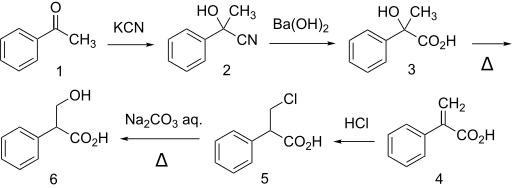Tropic acid: Difference between revisions
chembox data |
m Upright better than fixed pixel width |
||
| (46 intermediate revisions by 32 users not shown) | |||
| Line 1: | Line 1: | ||
{{chembox |
{{chembox |
||
|ImageFile= |
| ImageFile = Phenylhydracrylic acid.svg |
||
| ⚫ | |||
|ImageSize=200px |
|||
| ⚫ | |||
| ⚫ | |||
| ⚫ | |||
|Section1={{Chembox Identifiers |
|Section1={{Chembox Identifiers |
||
| CASNo_Ref = {{cascite|correct|CAS}} |
|||
| |
| CASNo = 529-64-6 |
||
| ⚫ | |||
| UNII_Ref = {{fdacite|correct|FDA}} |
|||
| ⚫ | |||
| UNII = 9RM4U80765 |
|||
| ⚫ | |||
| ⚫ | |||
| EINECS = 209-020-6 |
|||
| ChemSpiderID_Ref = {{chemspidercite|correct|chemspider}} |
|||
| ChemSpiderID = 10274 |
|||
| InChI = 1/C9H10O3/c10-6-8(9(11)12)7-4-2-1-3-5-7/h1-5,8,10H,6H2,(H,11,12) |
|||
| InChIKey = JACRWUWPXAESPB-UHFFFAOYAV |
|||
| StdInChI_Ref = {{stdinchicite|correct|chemspider}} |
|||
| StdInChI = 1S/C9H10O3/c10-6-8(9(11)12)7-4-2-1-3-5-7/h1-5,8,10H,6H2,(H,11,12) |
|||
| StdInChIKey_Ref = {{stdinchicite|correct|chemspider}} |
|||
| StdInChIKey = JACRWUWPXAESPB-UHFFFAOYSA-N |
|||
| RTECS = |
|||
| MeSHName = C011377 |
|||
| ChEBI_Ref = {{ebicite|correct|EBI}} |
|||
| ChEBI = CHEBI:30765 |
|||
| KEGG_Ref = {{keggcite|correct|kegg}} |
|||
| KEGG = C01456 |
|||
}} |
}} |
||
|Section2={{Chembox Properties |
|Section2={{Chembox Properties |
||
| |
| C=9 | H=10 | O=3 |
||
| |
| Appearance= |
||
| |
| Density= |
||
| MeltingPtC= 116 |
|||
| MeltingPt= |
|||
| |
| BoilingPt= |
||
| |
| Solubility= |
||
}} |
}} |
||
|Section3={{Chembox Hazards |
|Section3={{Chembox Hazards |
||
| |
| MainHazards= |
||
| |
| FlashPt= |
||
| AutoignitionPt = |
|||
| Autoignition= |
|||
}} |
}} |
||
}} |
}} |
||
'''Tropic acid''' is a laboratory reagent used in chemical synthesis of [[atropine]] and [[hyoscyamine]]. |
'''Tropic acid''' is a chemical with [[IUPAC]] name 3-hydroxy-2-phenylpropanoic acid and condensed [[structural formula]] HOCH<sub>2</sub>CH[[phenyl|Ph]]COOH. It is a laboratory reagent used in the chemical synthesis of [[atropine]] and [[hyoscyamine]]. Tropic acid is a [[chirality (chemistry)|chiral]] substance, existing as either a [[racemic mixture]] or as a single [[enantiomer]]. |
||
==Synthesis== |
|||
Tropic acid can be prepared by the [[Ivanov reaction]] between [[phenylacetic acid]] and [[formaldehyde]]. In this method, the dianion of the acid is formed using a [[Grignard reagent]], isopropyl magnesium chloride, and this reacts with the aldehyde to form the magnesium salt of the product, from which the pure acid is obtained after acidification with [[sulfuric acid]].<ref name=Blicke>{{cite journal |doi=10.1021/ja01121a504 |doi-access=free |title=The Preparation of Tropic Acid |date=1952 |last1=Blicke |first1=F. F. |last2=Raffelson |first2=Harold |last3=Barna |first3=Bohdan |journal=Journal of the American Chemical Society |volume=74 |page=253 }}</ref> |
|||
Many other methods have been used to make tropic acid, for example starting from [[acetophenone]] (1).<ref name=Gadzikowska>{{cite journal |pmid= 12365608 |year= 2002|last1= Gadzikowska|first1= M|title= Tropane alkaloids in pharmaceutical and phytochemical analysis|journal= Acta Poloniae Pharmaceutica|volume= 59|issue= 2|pages= 149–60|last2= Grynkiewicz|first2= G}}</ref> |
|||
:[[File:Tropicacidsynthesis1.svg|upright=2]] |
|||
==Uses== |
==Uses== |
||
Tropic acid is |
Tropic acid is used in the chemical synthesis of [[atropine]] and [[hyoscyamine]].<ref name=Blicke/> |
||
==References== |
|||
| ⚫ | |||
{{reflist}} |
|||
[[Category:Beta hydroxy acids]] |
|||
| ⚫ | |||
Latest revision as of 15:40, 4 July 2024

| |
| Names | |
|---|---|
| Preferred IUPAC name
3-Hydroxy-2-phenylpropanoic acid | |
| Other names
2-Phenylhydracrylic acid; Tropate
| |
| Identifiers | |
3D model (JSmol)
|
|
| ChEBI | |
| ChemSpider | |
| ECHA InfoCard | 100.008.201 |
| EC Number |
|
| KEGG | |
| MeSH | C011377 |
PubChem CID
|
|
| UNII | |
CompTox Dashboard (EPA)
|
|
| |
| |
| Properties | |
| C9H10O3 | |
| Molar mass | 166.176 g·mol−1 |
| Melting point | 116 °C (241 °F; 389 K) |
Except where otherwise noted, data are given for materials in their standard state (at 25 °C [77 °F], 100 kPa).
| |
Tropic acid is a chemical with IUPAC name 3-hydroxy-2-phenylpropanoic acid and condensed structural formula HOCH2CHPhCOOH. It is a laboratory reagent used in the chemical synthesis of atropine and hyoscyamine. Tropic acid is a chiral substance, existing as either a racemic mixture or as a single enantiomer.
Synthesis
[edit]Tropic acid can be prepared by the Ivanov reaction between phenylacetic acid and formaldehyde. In this method, the dianion of the acid is formed using a Grignard reagent, isopropyl magnesium chloride, and this reacts with the aldehyde to form the magnesium salt of the product, from which the pure acid is obtained after acidification with sulfuric acid.[1]
Many other methods have been used to make tropic acid, for example starting from acetophenone (1).[2]
Uses
[edit]Tropic acid is used in the chemical synthesis of atropine and hyoscyamine.[1]
References
[edit]- ^ a b Blicke, F. F.; Raffelson, Harold; Barna, Bohdan (1952). "The Preparation of Tropic Acid". Journal of the American Chemical Society. 74: 253. doi:10.1021/ja01121a504.
- ^ Gadzikowska, M; Grynkiewicz, G (2002). "Tropane alkaloids in pharmaceutical and phytochemical analysis". Acta Poloniae Pharmaceutica. 59 (2): 149–60. PMID 12365608.

